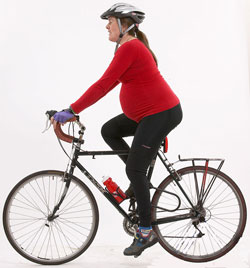Cycling during pregnancy – an individual choice
 A couple of my cycling buddies have recently told me of their pregnancies so I thought it would be a good topic to cover on Women Who Cycle. In fact, one of them told me while we were riding along on a regular weekend ride. This is not a topic that I’m an expert on, because I have not completed any formal training in healthcare or fitness, and I’ve never been pregnant, but I’ve done some research and compiled some expert opinion from others.
A couple of my cycling buddies have recently told me of their pregnancies so I thought it would be a good topic to cover on Women Who Cycle. In fact, one of them told me while we were riding along on a regular weekend ride. This is not a topic that I’m an expert on, because I have not completed any formal training in healthcare or fitness, and I’ve never been pregnant, but I’ve done some research and compiled some expert opinion from others.
The most important thing to note is that every women is different and so everyone needs to make their own decisions about how much to cycle during pregnancy or even if you cycle at all. Before you even consider it I urge you to discuss it and any other exercise plans with your doctor.
I asked around a bit and got a range of responses. One friend who had twins four years ago said that she rode her bike until her belly literally got in the way. She’s pretty experienced cyclists so she felt comfortable continuing with riding.
Another friend said she kept riding until she was six months pregnant and said it was just uncomfortable for her after that time. She did return to the bike only a few weeks after the birth and has never looked back.
One of my friends who is currently pregnant couldn’t ride for quite a few months because she was quite ill with morning sickness. She has recently returned to riding but has shortened her rides and is avoided any bunch riding.
And yet another friend gave up riding her bike early on in pregnancy because she felt that it wasn’t good for her baby but she’s kept riding her stationery trainer throughout. She attributes her easy pregnancy (so far anyway) with her fitness.
In doing my research, I found that the attitude towards cycling during pregnancy in countries like Denmark and The Netherlands where cycling is a very common form of transport, is quite different to countries like Australia where it’s not as accepted. In Denmark and The Netherlands it’s considered quite the norm to ride during pregnancy. I even read about a woman who rode to the hospital to give birth!
Gale Bernhardt in her excellent book Bicycling for Women devotes an entire chapter to exercising while pregnant which I would recommend. Here’s a few things I picked up from her book and other sources.
- Consider a higher handlebar height by changing the stem of your bike or even the handlebars themselves so you’re riding in a more upright position and if you’re uncomfortable on your regular saddle consider switching to a wider one during pregnancy.
- Reduce your overall time in the saddle by going for shorter rides and break your ride into smaller segments so you are resting a bit more than usual.
- It is critical to stay well hydrated, as dehydration has been associated with premature labour. This can mean more time out of the saddle as you head for the loo but at least you get a little break at the same time.
- Don’t push yourself too hard. Some people recommend that your heart rate should not exceed 140 beats per minute, while others use a perceived exertion rate measure. This is a very individual issue, based on the amount you exercised before pregnancy and other factors and should be discussed with your doctor.
- Use good judgement and reduce intensity, or stop exercise when fatigue sets in and don’t exercise at all if you are feeling ill.
- Stop riding if you get dizzy, pain, headaches or short of breath.
- Do what feels right for you and your baby. Don’t let other (well meaning) people impose their attitudes on you.
You might also enjoy reading this nice blog post from a woman called Jaime from San Francisco who rode her bike right up until the day she went into labour.
All data and information provided on this site is for informational purposes only. womenwhocycle.com makes no representations as to accuracy, completeness, currentness, suitability, or validity of any information on this site and will not be liable for any errors, omissions, or delays in this information or any losses, injuries, or damages arising from its display or use. All information is provided on an as-is basis.
